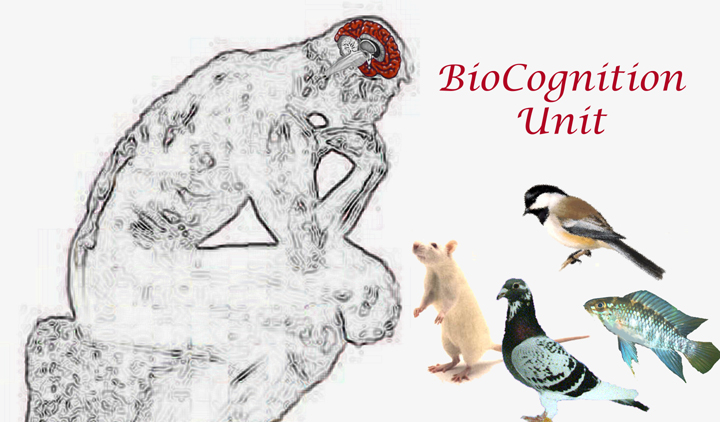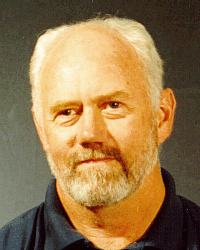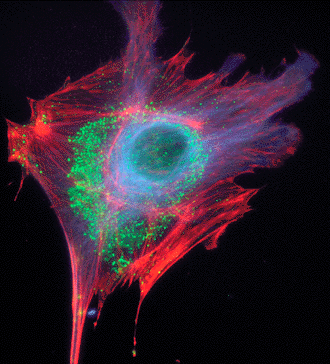|
BioCognition is a new, integrated approach to understanding the biological basis of cognition in organisms throughout the animal kingdom. The University of Alberta has a unique group of internationally-recognized researchers in the fields of comparative cognition and behavioural and systems neuroscience. This Unit enhances the research of individual researchers and facilitates the development of thematically cohesive research programs. Our research investigates cognitive processes, such as perception, memory and navigation, from many levels of analysis, from genes to the behavior of whole organisms. We share a common interest in cognitive and brain processes underlying behaviour, and a belief that understanding these processes is through an integrative comparative approach.
|
|||||
|
BioCognition - thinking inside the black box.
|
|||||
|
|
Members | Publications | Students | Opportunities | Courses |
|
|
|
||||
| Associate Members
|
|
||||
|
Marcia Spetch and Eric Legge in Express News!
2009 / In Press
Dickson Whitten TA, Martz LJ, Guico A, Gervais N, Dickson CT, (in press) Heat synch: Inter- and independence of body temperature fluctuations and brain state alternations in urethane-anesthetized rats. J Neurophysiol Nazer F & Dickson CT, (in press) The slow oscillation state facilitates epileptiform events in the hippocampus. J Neurophysiol Schall K, and Dickson CT, (in press) Changes in hippocampal excitatory synaptic transmission during cholinergically-induced theta and slow oscillation states. Hippocampus Engin E, Treit D, and Dickson CT (2009) Anxiolytic- and antidepressant-like properties of ketamine in behavioral and neurophysiological animal models. Neuroscience 161: 359-369.
Grant Grant, D. S. (in press). Use of samples differing markedly in salience may encourage use of a single-code/default strategy in matching-to-sample in pigeons. Learning and Motivation. Grant, D. S. (in press). Choose-long errors at delays shorter than the training delay persist when enhanced between-trial summation of memories are precluded in duration matching in pigeons. Behavioural Processes.
Hurd Garamszegi LZ, Calhim S, Dochtermann N, Hegyi G, Hurd PL, Jørgensen C, Kutsukake N, Lajeunesse MJ, Pollard KA, Schielzeth H, Symonds MRE, Nakagawa S. in press. Changing philosophies and tools for statistical inferences in behavioral ecology. to appear in Behavioural Ecology Guillette LM, Reddon AR, Hurd PL, Sturdy CB. in press. Exploration of a novel space is associated with individual differences in learning speed in black-capped chickadees, Poecile atricapillus. to appear in Behavioural Processes. Reddon AR & Hurd PL. in press. Acting unilaterally: Why do animals with strongly lateralized brains behave differently than those with weakly lateralized brains? to appear in Bioscience Hypotheses. (doi:10.1016/j.bihy.2009.06.007) Enquist M, Hurd PL & Ghirlanda S. in press. Signalling, Chapter 16 in Westneat DF & Fox CW (eds) Evolutionary Behavioral Ecology, Oxford University Press. Reddon AR & Hurd PL. 2009. Sex differences in the cerebral lateralization of a cichlid fish when detouring to view emotionally conditioned stimuli. Behavioural Processes 82: 25-29. (doi:10.1016/j.beproc.2009.03.005) Yan RH, Brunning M, Wahlsten D & Hurd PL. 2009. Digit ratio (2D:4D) differences between 20 strains of inbred mice. PLoS ONE. 4: e5801. (doi:10.1371/journal.pone.0005801) Reddon AR, Gutierrez-Ibanez C, Wylie DR & Hurd PL. 2009. The relationship between growth, brain asymmetry and behavioural lateralization in a cichlid fish. Behavioural Brain Research 201: 223-228. (doi:10.1016/j.bbr.2009.02.015) Laplante DP, Bouchard I, Hurd PL, Brunet A, & King S, 2009. Project Ice Storm: Effects of Prenatal Maternal Stress on Physical Development. Annals of Behavioral Medicine 37: s23. Hamblin S & Hurd PL. 2009. When will evolution lead to deceptive signalling in the Sir Philip Sidney game? Theoretical Population Biology 75: 176-182. (doi:10.1016/j.tpb.2009.02.002) Reddon AR & Hurd PL. 2009. Differences in aggressive behavior between convict cichlid color morphs: amelanistic convicts lose even with a size advantage. Acta Ethologica 12 49-53. (doi:10.1007/s10211-009-0054-9) Moroschan G, Hurd PL, Nicoladis E. 2009. Sex differences in the use of indirect aggression in adult Canadians. Evolutionary Psychology. 7: 146-159. (PDF) Hurd PL. 2009. Honest Signaling. In Encyclopedia of Animal Behavior. M. D. Breed & J. Moore (eds.). Elsevier Press. Reddon AR & Hurd PL. 2009. Individual differences in cerebral lateralization are associated with shy-bold variation in the convict cichlid. Animal Behaviour 77: 189-193. (doi:10.1016/j.anbehav.2008.09.026)
Spetch Dawson, M.R.W., Dupuis, B., Spetch, M.L., & Kelly, D.M. (in press). Simple artificial neural networks that match, exploit, and explore when confronting a multiarmed bandit. IEEE Transactions on Neural Networks (Accepted for publication June 9, 2009) Batty, E. R., Bloomfield, L. L., Spetch, M. L. & Sturdy, C. B. (2009). Comparing black-capped (Poecile atricapillus) and mountain chickadees (Poecile gambeli): use of geometric and featural information in a spatial orientation task. Animal Cognition, 12,633-641. Legge, E. L., & Spetch, M. L. (2009). The differential outcomes effect (DOE) in spatial localization: An investigation with adults. Learning and Motivation. 40, 313-328 Friedman, A., Voung, Q.C. & Spetch, M.L. (2009). View combination in moving objects: The role of motion in discriminating between novel views of similar and distinctive objects by humans and pigeons. Vision Research, 49, 594-607. Talbot, K.J., Legge, E.L.G., Bulitko, V. & Spetch, M.L. (2009). Hiding and searching strategies of adult humans 3 in a virtual and a real-space room. Learning and Motivation, 40, 221-233. Legge, E.L.G., Spetch, M.L. & Batty, E. R. (2009). Pigeons’ (Columba livia) hierarchical organization of local and global cues in touch screen tasks. Behavioural Processes. 80, 128-139.
Sturdy Guillette, L.M., Reddon, A.R., Hurd, P.L., & Sturdy, C.B. (In press, 20 July 2009). Exploration of a novel space is associated with individual differences in learning speed in black-capped chickadees, Poecile atricapillus. Behavioural Processes. Hoeschele, M., Gammon, D.E., Moscicki, M.K., & Sturdy, C.B. (In press, 15 July 2009). Note types and coding in Parid vocalizations: the chick-a-dee call of the chestnut-backed chickadee (Poecile rufuscens). To appear in Journal of the Acoustical Society of America. Proppe, D.S., & Sturdy, C.B. (In press, 25 June 2009). The effect of schedules of reinforcement on the composition of spontaneous and evoked black-capped chickadee calls. To appear in Journal of Experimental Biology. Batty, E.R., Bloomfield, L.L., Spetch, M.L., & Sturdy, C.B. (2009). Black-capped (Poecile atricapillus) and mountain chickadees' (Poecile gambeli) use of geometric and featural information in a spatial orientation task. Animal Cognition, 12, 633-641.
Treit Engin E, Treit D. Somatostatin SST-2 receptors mediate the anxiolytic- and antidepressant-like effects of somatostatin. In Press, Psychopharmacology. Engin E, Treit D, Dickson CT. Anxiolytic- and antidepressant-like properties of ketamine in behavioral and neurophysiological animal models. In press, Neuroscience. McEown, K, Treit, D (2009). The role of the dorsal and ventral hippocampus in fear and memory of a shock-probe experience. Brain Research, 1251, 185-194. Treit D, Engin E, McEown K. Animal models of anxiety and anxiolytic drug action. Invited Book chapter in press, Behavioral Neurobiology of Anxiety and its Treatment, Current Topics in Behavioral Neurosciences (CTBN) book series, in press, Springer.
Wylie Iwaniuk AN, Lefevbre L, Wylie DR (2009) The comparative approach and brain-behaviour relationships: A tool for understanding tool use. Canadian Journal of Experimental Psychology 63:150-159. Reddon AR, Gutierrez-Ibanez C, Wylie DR, Hurd PL (2009) The relationship between growth, brain asymmetry and behavioural lateralization in a cichlid fish. Behavioural Brain Research 201:223-228. Iwaniuk AN, Marzban H, Pakan JMP, Watanabe M, Hawkes R, Wylie DRW (2009) Compartmentation of the cerebellar cortex of hummingbirds (Aves: Trochilidae) revealed by the expression of zebrin II and phospholipase Cb4. Journal of Chemical Neuroanatomy 37: 55-63.
|
|||||
|
Students,
Postdocs and Research Associates in the Unit Undergraduate Students Zahid Padamsey, Summer student
Graduate Students Marc Avey (Ph.D. student, Sturdy) Elif Elgin (Ph.D. student, Treit) Emily Batty (Ph.D. student, Spetch) David Graham (M.Sc. student, Wylie) Lauren Guillette (Ph.D. student, Sturdy) Cristian Gutierrez (M.Sc. student, Wylie) Marisa Hoeschele (M.Sc. student, Sturdy) Hang Huynh (Ph.D. student, Wylie) Matt Ian Helgesen (M.Sc. student, Hurd) Eric Legge (M.Sc. student, Spetch) Kris Mceown (Ph.D. student, Treit) Michele Moscicki (M.Sc. student, Sturdy) Jean-Francois Nankoo (Ph.D. sturdy, Spetch) Farhang Nazer (M.Sc. student, Dickson) Janelle Pakan (Ph.D. student, Wong-Wylie) Darren Proppe, (Ph.D. student, Sturdy) Adam Reddon (M.Sc. student, Hurd) Arjun Sharma (M.Sc.student, Dickson) Trish Wolansky (Ph.D. student, Dickson) Tara Whitten (Ph.D. student, Dickson)
Postdocs / Research Associates Philip De Guzman (PDF, Dickson) Elliot Ludvig (PDF, Computing Science, U of Alberta, Spetch) Milan Njegovan (Adjunct Professor, Sturdy)
|
|||||
|
Research Opportunities in the Unit Members of the BCU are always seeking highly motivated undergraduate students, graduate students and post doctoral fellows to conduct research projects. There are several sources of funding for which students and post docs may apply; what follows is a summary of some of the main sources of funding, along with links to the appropriate pages of funding agencies' web sites. Undergraduate students may apply for an NSERC undergraduate student research award (USRA). This award, along with a supplement from their research supervisor, provides students with approximately $1,400 per month for four months, from May through August. Undergraduate students may also apply for an AHFMR Heritage Summer Studentship worth $1,300 per month for between 2 - 4 months. Graduate students may apply for NSERC post-graduate scholarships (PGS-M and PGS-D); these awards fund graduate students for two years at approximately $19,000 and $21,000 per year, respectively. Graduate students who apply for a PGS A or B will also be considered for a Canada Graduate Scholarship (CGS). These awards provide increased funding at both the master's and doctoral levels. Graduate students may also apply for a CIHR Doctoral Research Award, worth $22,000 per year for up to three years ($21,000 stipend, $1,000 research allowance). Graduate students may also apply for Alberta Ingenuity Fund Studentships. These awards are valued at approximately $23,500 ($22,000 in salary, $1,500 in research expenses) per year for five years and can also be used as a top-up supplement for those students who hold an NSERC PGS award. Graduate students may also apply for an AHFMR Health Research Studentship worth between $19,000 - $21,000 per year in stipend and between $1,000 - $1,500 per year in research allowance. If a trainee receives another major, peer-reviewed award along with an AHFMR award, they may be eligible to receive 30% of the value of the outside award or the maximum percentage allowable by the other agency or $7,000, whichever is the least. The trainee will also receive the AHFMR allowance ($3,000 for fellowships). Graduate students may also apply for several University-administered awards of various valuations and for various durations. Postdoctoral fellows may apply for an NSERC postdoctoral fellowship (PDF) valued at $40,000 per year for two years, or a CIHR fellowship valued at up to $55,000 per year for up to 5 years. Postdoctoral fellows may also apply for an AHFMR Fellowship worth $35,000 - $45,000 per year, and also includes a research allowance of $3,000 per year. As with the Alberta Ingenuity Fellowship, AHFMR awards fellows a stipend supplement. If a trainee receives another major, peer-reviewed award along with an AHFMR award, they may be eligible to receive 30% of the value of the outside award or the maximum percentage allowable by the other agency or $7,000, whichever is the least. The trainee will also receive the AHFMR allowance ($3,000 for fellowships). Postdoctoral fellows may also apply for either a Notely or Killam postdoctoral fellowship, through the Faculty of Graduate Studies and Research at the University of Alberta. These awards are worth $40,000 per year in salary for two years and come with a one-time award of $4,000 to be used for research and conference expenses.
|
|||||
|
NEURO 410 - Neurobiology of Aging and Neurodegenerative Disorders - Dr. Dickson PHYSL 444 - Advanced Topics in Neurophysiology - Dr. Dickson PMCOL 371 - Cellular Neuroscience - Fall 2007 - Dr. Dickson PSYCO 402/505 - Methods & Analysis of Neurophysiological Time Series Data - Dr.Dickson PSYCO 267 - Perception - PSYCO 275 - Brain and Behaviour - PSYCO 381 - Principles of Learning - Fall 2009 - Dr. Sturdy PSYCO 403/505 - Animal Communication - Fall 2009 - Dr. Sturdy PSYCO 403 - Neuroscience of Perceptual Systems - Dr. Wong-Wylie PSYCO 403/505 - Spatial Cognition and Navigation - Fall 2009 -Dr. Spetch PSYCO 485 - Dr. Spetch
|
|||||
|
Copyright of BioCognition Unit, 2009, all
rights reserved |
|||||









